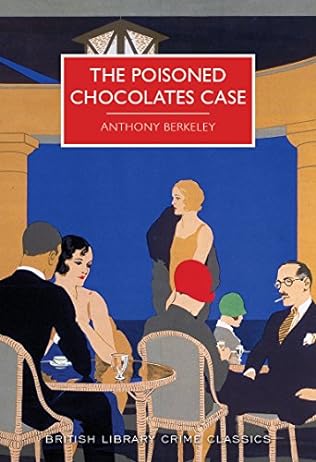A review of The Poisoned Chocolates Case by Anthony Berkeley – 240221
It is fascinating to have one’s assumptions and, indeed, expectations of a murder mystery challenged from time to time. One of the attractions of the cosy style murder is that out of chaos order emerges as the sleuth uses their powers to assemble a convincing picture out of a multiplicity of clues, be they physical or chance remarks, to bring the malefactor to justice. Occasionally, the puzzle might be nuanced that there are a couple of solutions and the reader is left to use their own judgment as to what really happened. The underlying assumption is that each clue is really only capable of having one interpretation and it is that which the writer through their sleuth allows to settle in the reader’s mind.
Anthony Berkeley drives a coach and horses through these preconceptions in his enthralling and thought provoking The Poisoned Chocolates Case, the fifth in his Roger Sheringham series, originally published in 1929 and reissued, rightly, as part of the British Library Crime Classics series. The novel’s premise is simply brilliant. Give six people who have earned their “criminological spurs” the same set of facts and clues of a case which has to date baffled the police, represented by Chief Inspector Moresby, and give them a week to see what they make of it. Using a range of detective techniques, ranging from the deductive to the inductive and all points between, and pursuing their own investigations through a mixture of large tips to key informants and plundering their impressive lists of personal contacts, it is perhaps unsurprising that they come up with six different answers.
The six amateur detectives are members of Sheringham’s Crime Circle, a forerunner of the Detection Club which Berkeley was instrumental in establishing the following year, and the case presented to them is the murder of Joan Bendix who died after ingesting some chocolates, each of which had been injected with precisely six minims of nitrobenzene, a flavouring agent used in chocolate manufacturing and toxic in large doses. The chocolates had been given to her by her husband, Graham Bendix, who had received them in the Rainbow Club from Sir Eustace Pennefather, who, in turn, had unexpectedly received them in the post. Bendix had eaten a couple of the chocolates and was, like his wife, unwell but survived the experience.
Sir Eustace was an acknowledged womaniser who had, amusingly and somewhat embarrassingly for the Circle, had had a dalliance with the daughter of one of their own members, the lawyer Sir Charles Wildman, but his conquests were more extensive. As the investigations progress, it emerges that each of the protagonists have their own dark secrets that could be motive enough for committing murder most foul. The police’s working theory is that it is the work of a fanatic who wanted to rid the world of Pennefather in a plot that went wrong.
Sir Charles Wildman fingers Lady Pennefather, Mrs Fielder-Fleming Sir Charles, Bradley in his two attempts concludes logically that it could have been him before positing that it was a woman unknown, one of Pennefather’s discarded mistresses, Sheringham puts forward a case that the culprit is Bendix, Miss Dammers asserts that it is Sir Eustace, and the nervous ad unassuming Mr Chitterwick goes for Miss Dammers.
The reader, of course, is free to make up their own mind and the British Library reissue includes two further reconstructions, one from Christianna Brand and the other from Martin Edwards. I took the decision not to read these until a day after I had read Berkeley’s original so that I would not be overly influenced by the later suggestions.
Berkeley has produced an eye-opening experiment that shows that facts and clues can be manipulated to the creator’s own ends. It is brought off with some verve and panache in a well written and humorous novel. The word classic is bandied about too loosely these days but this book rightly wears that crown.
Just be careful what you eat this Easter!




